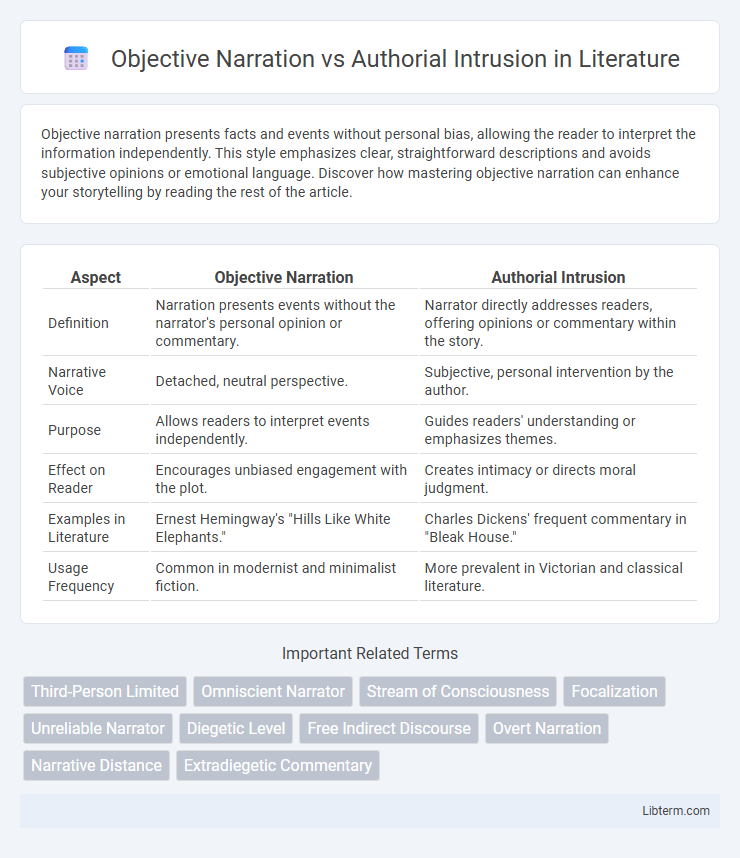Objective narration presents facts and events without personal bias, allowing the reader to interpret the information independently. This style emphasizes clear, straightforward descriptions and avoids subjective opinions or emotional language. Discover how mastering objective narration can enhance your storytelling by reading the rest of the article.
Table of Comparison
| Aspect | Objective Narration | Authorial Intrusion |
|---|---|---|
| Definition | Narration presents events without the narrator's personal opinion or commentary. | Narrator directly addresses readers, offering opinions or commentary within the story. |
| Narrative Voice | Detached, neutral perspective. | Subjective, personal intervention by the author. |
| Purpose | Allows readers to interpret events independently. | Guides readers' understanding or emphasizes themes. |
| Effect on Reader | Encourages unbiased engagement with the plot. | Creates intimacy or directs moral judgment. |
| Examples in Literature | Ernest Hemingway's "Hills Like White Elephants." | Charles Dickens' frequent commentary in "Bleak House." |
| Usage Frequency | Common in modernist and minimalist fiction. | More prevalent in Victorian and classical literature. |
Understanding Objective Narration
Objective narration presents the story through an impartial, fact-based viewpoint that avoids revealing the narrator's personal opinions or emotions, allowing readers to interpret events independently. This style relies on observable actions, dialogue, and external descriptions without providing insight into characters' inner thoughts or motivations. Understanding objective narration helps writers create a neutral narrative voice that emphasizes transparency and trustworthiness in storytelling.
Defining Authorial Intrusion
Authorial intrusion occurs when the narrator directly addresses the reader or offers personal commentary, disrupting the story's flow and breaking the narrative illusion. Unlike objective narration, which maintains an impartial and immersive perspective, authorial intrusion draws attention to the presence of the author within the text. This technique can influence reader interpretation by guiding responses or highlighting themes explicitly.
Key Differences Between the Two Techniques
Objective narration maintains a neutral and unbiased perspective, presenting facts and events without revealing the narrator's personal opinions or emotions. Authorial intrusion involves the narrator directly addressing the reader with commentary, opinions, or additional context beyond the story's immediate events. The key difference lies in the level of narrator presence, where objective narration minimizes subjective input, while authorial intrusion actively inserts the narrator's voice into the narrative.
Advantages of Objective Narration
Objective narration offers readers an unbiased and immersive experience by presenting events and characters without the author's direct commentary, allowing for a more authentic and engaging story. This technique enhances the reliability of the narrative while encouraging readers to interpret the plot and characters independently. By minimizing authorial intrusion, objective narration maintains narrative neutrality, which can increase suspense and emotional impact.
Benefits of Authorial Intrusion
Authorial intrusion allows writers to directly communicate with readers, providing deeper insights, context, or commentary that enriches the narrative and clarifies complex themes. This technique fosters a stronger author-reader connection by offering personal reflections or guiding interpretations, enhancing engagement and emotional resonance. By strategically inserting the author's voice, the narrative gains flexibility and can address ambiguities or narrative gaps more effectively than strict objective narration.
Impact on Reader Engagement
Objective narration maintains a neutral and impartial tone, allowing readers to interpret events and characters independently, which fosters deeper immersion and personal connection. Authorial intrusion breaks the narrative flow by directly addressing the reader or inserting opinions, potentially disrupting immersion but enhancing clarity and thematic emphasis. Balancing these techniques influences reader engagement by either preserving narrative distance or intensifying emotional involvement through the author's explicit commentary.
Common Uses in Literary Genres
Objective narration dominates genres like modernist fiction and crime novels, where authors prioritize unbiased storytelling to enhance realism and reader interpretation. Authorial intrusion appears frequently in metafiction, satire, and epic poetry, serving to break the fourth wall or provide commentary that guides reader analysis. Historical fiction may blend both techniques, using objective narration for plot development while authorial intrusion offers contextual background or thematic emphasis.
Famous Examples in Literature
Objective narration maintains a neutral, unbiased perspective, as seen in Hemingway's *The Old Man and the Sea*, where the third-person narration avoids emotional commentary. Authorial intrusion breaks the narrative flow by directly addressing readers, exemplified by Charles Dickens in *Bleak House*, where he interjects personal opinions and social critiques. These contrasting techniques shape reader engagement by either preserving narrative objectivity or highlighting the author's voice.
Choosing the Right Narrative Approach
Choosing between objective narration and authorial intrusion depends on the desired level of author presence and reader engagement in storytelling. Objective narration offers a detached, unbiased perspective, allowing readers to interpret events independently, which is ideal for maintaining suspense and realism. In contrast, authorial intrusion directly guides interpretation and injects the author's voice, enhancing thematic emphasis and providing deeper insight into characters or events.
Blending Objectivity and Intrusion Creatively
Blending objective narration with authorial intrusion allows writers to maintain an impartial narrative voice while subtly guiding readers' interpretations through strategic commentary. This technique enhances storytelling by balancing factual recounting with insightful perspectives, enriching the narrative without overwhelming it. Effective use of this blend sharpens thematic depth and engages readers by merging unbiased description with creative authorial presence.
Objective Narration Infographic

 libterm.com
libterm.com